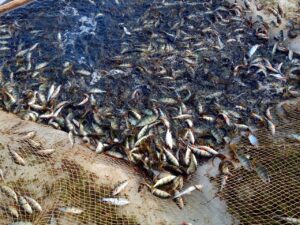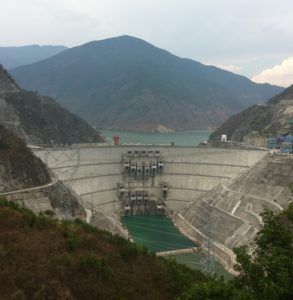CORVI National Workshop in Dhaka
On December 13, 2022, the Ocean Policy Research Institute-Sasakawa Peace Foundation (OPRI-SPF) and the U.S.-based Stimson Center traveled to Dhaka, Bangladesh to present the Climate and Ocean Research Vulnerability Index (CORVI) Chattogram risk assessment. The team included Dr. Emadul Islam (OPRI-SPF), Dr. Santosh Kumar Rauniyar (OPRI-SPF), Ms. Natalie Fiertz (Stimson Center), and Ms. Lily Schlieman (Stimson Center). This project team participated in a session of the 10th Eastern Himalayan Naturenomics Forum at Independent University Bangladesh. The session was entitled “CORVI Risk Profile: Chattogram, Bangladesh – A Holistic Based Assessment of the Climate Risks Facing Chattogram.”
Dr. Miko Maekawa of the Ocean Policy Research Institute-Sasakawa Peace Foundation (OPRI-SPF) provided opening remarks praising the consistent engagement with key stakeholders through the assessment process and the commitment of the government of Bangladesh to strengthening climate resilience. The Bangladesh Minister of Planning Mr. M. A. Mannan then provided remarks about the importance of understanding climate vulnerability and strengthening coastal resilience in Bangladesh and the role that CORVI can play in supporting the implementation of the Delta Plan 2100.
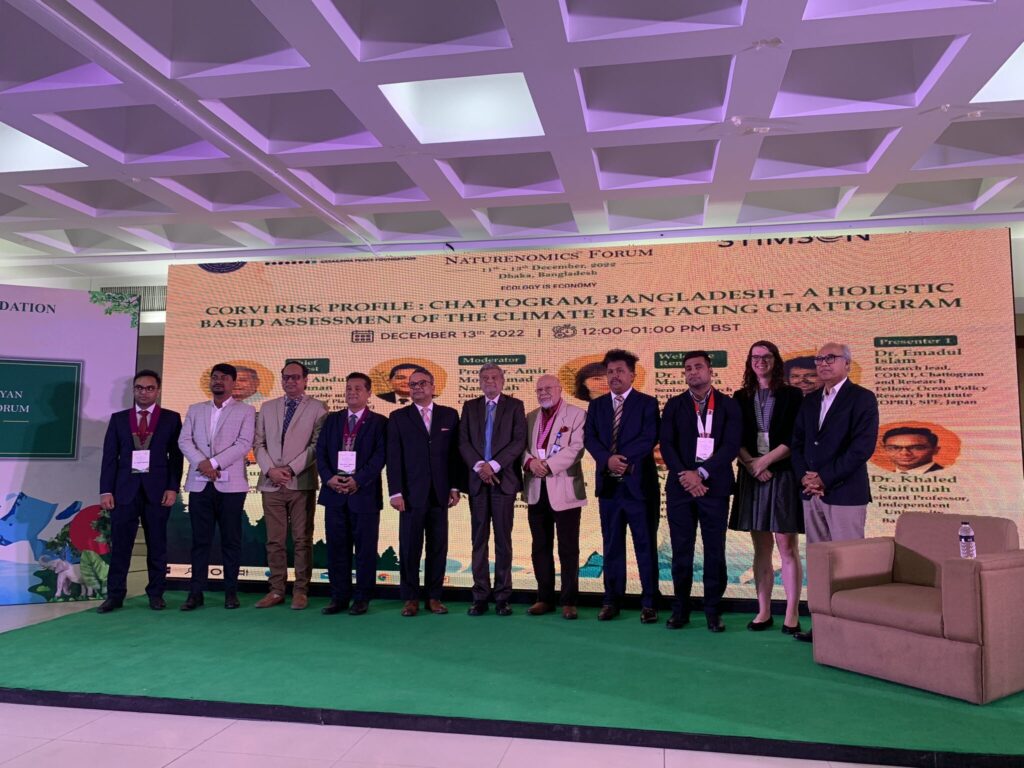
Three members of the project team presented on the CORVI Chattogram assessment. Dr. Emadul Islam (OPRI-SPF) presented the process, findings, and recommendations of the assessment (see below). Ms. Natalie Fiertz (Stimson Center) provided an overview of the CORVI project and the ways that previous CORVI assessments have been used to inform climate resilience planning and prioritization. Dr. Santosh Kumar Rauniyar (OPRI-SPF) presented on the methodological robustness of the CORVI process.
Following the presentations, Professor Dr. Amir Mohammad Nasrullah of the University of Chittagong moderated comments on the CORVI Chattogram assessment with four climate experts:
- Professor Dr. Golam Mathbor of Monmouth University (virtual)
- Mr. M. Zakir Hossain Khan, Chief Executive of Change Initiative
- Dr. Niaz Ahmed Khan, Vice Chancellor, Independent University Bangladesh
- Architect Abdullah Al Omar, City Planner, Chattogram City Corporation
The speakers highlighted the risks and vulnerabilities that Chattogram faces due to climate change, emphasized the importance of stakeholders’ involvement in managing these risks, and praised the findings and the policy inputs suggested by the CORVI Bangladesh team.
Closing remarks were provided by Dr. Khaled Saifullah, Assistant Professor at Independent University Bangladesh, who noted the value offered by close partnerships between academia and policymakers so that policymaking and decision-making can be informed by the most up-to-date research findings.
Meeting with Young Power in Social Action (YPSA) in Chattogram
On December 14, 2022, the project team, joined by Professor Dr. Amir Mohammad Nasrullah, met with members of Young Power in Social Action (YPSA), to present. Following a brief presentation on the CORVI Chattogram assessment and, the group discussed the findings. Topics that received particular attention during the discussion included Chattogram’s shipbreaking industry, the destruction of mangroves, the displacement of rural populations by extreme weather events, the shortcomings in implementing climate change resilience plans, and the challenges associated with solid waste management received notable attention during these discussions. Members of YPSA also emphasized the value of the assessment in informing consultations around the new city master plan currently under development by the Chattogram Development Authority.
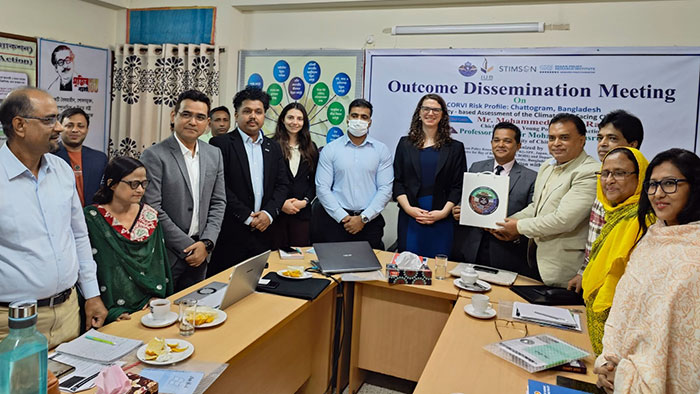
Meeting with the Chattogram Development Authority (CDA)
On December 14, 2022, the project team, joined by Professor Dr. Amir Mohammad Nasrullah, met with members from of the Chattogram Development Authority (CDA), including the Chairman of the CDA. The group discussed the findings and recommendations of the CORVI Chattogram assessment, particularly the issue of waterlogging, challenges associated with fragmented governance, and difficulties with implementing climate resilience plans. The group also discussed how the findings and recommendations in the assessment can help inform the development of the new city master plan, which the CDA is currently developing.
Meeting with the Chattogram City Corporation (CCC)
On December 14, 2022, the project team, joined by Professor Dr. Amir Mohammad Nasrullah, met with members from the Chattogram City Corporation (CCC), including the mayor. The group discussed the findings and recommendations of the CORVI Chattogram assessment, with a particular focus on how the report findings could be publicized and disseminated in local media. They also highlighted how the report can be used to help the CCC mobilize climate resilience financing, especially from international partners such as the Global Environment Facility and Green Climate Fund.
Meeting with Secretary of Ministry of Disaster Management and Relief in Dhaka
On December 15, 2022, the project team met with representatives from the National Ministry of Disaster Management and Relief. The group discussed the findings and recommendations of the CORVI Chattogram assessment, with the representatives emphasizing the importance of disseminating the report to all relevant agencies and ministries from the national government of Bangladesh, using the report to mobilize technical and financial assistance from development partners. The conversation further highlighted the priority placed on developing the blue economy by the Prime Minister and Minister of Planning.
Next Steps
Throughout the engagements, the team received very positive feedback on the findings and recommendations included in the CORVI Chattogram assessment. Representatives from national and local governments, as well as civil society, noted the utility of the report for their work. The Minister of Planning mentioned that the report’s findings and recommendations would be valuable in helping the government translate the Bangladesh Delta Plan 2100 – the government’s flagship long-term plan to pursue climate resilient economic development – into concrete actions on the ground in Chattogram.
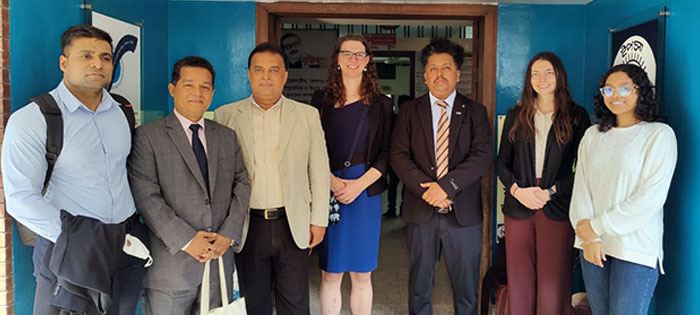
The Chairman of the Chattogram Development Authority and the CEO of Young Power in Social Action described plans to use the report to inform and influence the Chattogram Master Plan that is currently being developed and will guide the city’s decision-making through 2041. The city’s mayor and chief executive of the Chattogram City Corporation expressed his plan to explore using the report to help the city access technical and financial assistance from sources like the Green Climate Fund.
Key Findings and Recommendations from CORVI Chattogram
Chattogram, the second-largest city in Bangladesh, is the busiest seaport on the Bay of Bengal. The city is home to over 3.9 million people, with approximately 5.3 million living in the broader urban area. The city accounts for 40% of the country’s industrial output, 80% of its international trade, and 50% of the government’s revenue.
Notable vulnerabilities identified include:
- A growing urban population which in the last decade has grown from 4.3 million to 5.3 million in the urban area, a 23% increase, and is projected to reach over 7 million by 2035. Approximately one-quarter of this population lives in informal settlements, which are more vulnerable to climate risks and have lower access to public services.
- Growing risks from extreme weather events, especially tropical cyclones and landslides. In October 2022, Chattogram was struck by Cyclone Sitrang, which saw over one million people evacuated nationwide. The 1991 Super Cyclonic Storm killed 140,000 nationwide, including 25,000 in Chattogram. Fortunately, disasters of that magnitude have not been repeated. Cyclones and other storms can trigger landslides, which have increased in frequency and severity, exacerbated by the deforestation of the city’s hills.
- Vulnerable marine and coastal ecosystems are threatened by habitat destruction, heavy metal pollution from the shipbreaking industry, untreated wastewater, solid waste disposal in the Bay of Bengal, and pollution from aquaculture operations. This degrades the protection from erosion and storm surges offered by these ecosystems.
- A large informal economy, which accounts for around 85% of employment in Chattogram. Workers in the informal economy are largely excluded from social safety net programs and, are more vulnerable to economic shocks. They also pay fewer taxes, reducing the financial resources available for climate resilience investment.
- Fragmented governance characterized by overlapping and intersecting mandates and management plans, which tends to slow decision-making and inhibit effective maintenance.
Priority recommendations:
- Improve and expand flood adaptation and waste management, building on the very successful early warning system that has reduced fatalities from extreme weather events. The next steps in strengthening flood adaptation could include improving solid waste collection, protecting and restoring coastal and marine ecosystems that can provide protection against storm surges, and ensuring that all residents have access to the financial resources needed to adapt to and recover from flooding.
- Improve urban climate resilience implementation and invest in climate-smart infrastructure to strengthen public service delivery and the construction and maintenance of critical infrastructure. This could include clarifying and simplifying lines of authority and responsibility around key public services, obtaining broad stakeholder buy-in for the new master plan, adopting performance-based agreements, and exploring innovative ways to raise adaptation finance.
- Implement a sustainable shoreline development strategy. This could include regulating development in hazard-prone areas, improving wastewater and solid waste management to reduce pollution in the Bay of Bengal and local rivers, and considering innovative solutions like creating artificial reefs from sunken ships.



